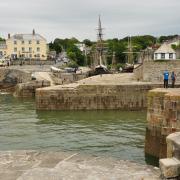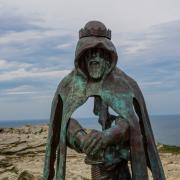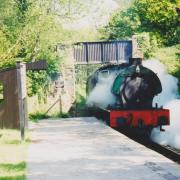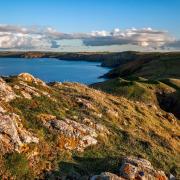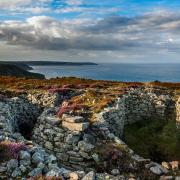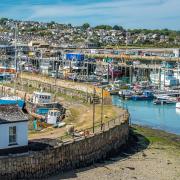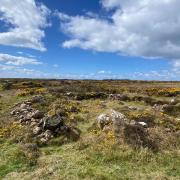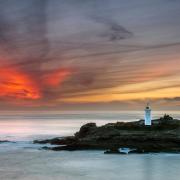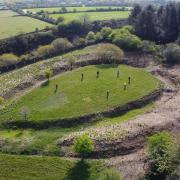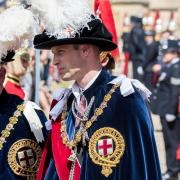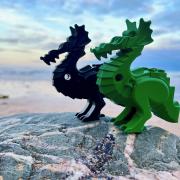A stunning collection of photographs, taken by five generations of the same family, have recorded over a century of shipwrecks along the Cornish coast.
It’s November, 1895. A small group of ladies and gentlemen, along with three little girls, wearing their ‘Sunday best’ hats and coats, stand on the cliff edge at Porthcurno. One lady balances a telescope on the shoulder of her companion. All eyes are turned to the scene in the cove below, where a beautiful three-masted ship, lies foundering in the water. Tiny figures can be seen on the deck, but the waves are just about coming overboard…
As The Cornishman newspaper reported at the time, ‘Her masts seem to totter, her sails hang shroudlike… The picture might well be called, The End of a Voyage.’
Extraordinary scenes of shipwrecks like that of the Granite Slate, all photographed while they were happening, have been captured by five generations of one family from the Isles of Scilly.
Thousands of images of shipwrecks were taken by Gibson & Sons of Scilly, going back to the earliest days of photography,

The family’s obsession with photographing shipwrecks began with Irish-born John Gibson who moved to the Isles of Scilly in 1827. He went to sea, later became shopkeeper then set up a photographic studio at St Mary’s in 1870. Becoming editor of a local newspaper, John had begun filing reports and photographing shipwrecks, most notably the Schiller a German steamship that sank off Bishop Rock Lighthouse with the loss of over 300 lives.
The work continued with John’s son Alexander, then Alexander’s brother, Herbert, who worked alongside his brother for five decades. They were living in Penzance during the winter months, spending summers on the Isles of Scilly. The business continued with Alexander’s son James, who ran a studio on St Mary’s, then his son Frank, who had begun working for his father from the age of 17. It was always difficult making enough money from photography alone, so Frank had a small shop on St Mary’s selling souvenirs and books, including prints of the shipwreck photos. The business and the photographic collection, passed on to Frank and his wife Marie’s daughter, Sandra, who also worked as a photographer for the family business and became keeper of the family’s whole photographic archive.

Sandra Kyne, nee Gibson, grew up on St Mary’s and she and her sisters would help their parents create the prints. The shipwreck photos had always provided a much-needed extra source of income for the family, whether it was selling prints to newspapers, providing evidence for insurance companies, or even selling prints for the captains and crews of the wrecked boats. In later year, during Frank’s tenure, the tourism side really took off.
‘The entire back wall of the shop was dedicated to a display of the shipwreck images,’ says Sandra. When I was young mum and dad would spend the winter-time in the dark room, hand-printing everything. The whole process was incredibly laborious and then prints were trimmed and stamped. As children, our job was to write in very soft pencil on the back of the print the name of the wreck, where it was wrecked and the date. That was many a winter’s evening, sat at our kitchen table doing that. It was like a production line.’
Frank was a pragmatic businessman, says Sandra, but there was another side too. ‘Me and my dad were inseparable when I was growing up. I’d go off with him everywhere when he was taking pictures and I remember saying to him, ‘Why are we doing this?’ And he said, ‘I’m just recording it.’ He was very passionate about taking pictures to record what might become history in time. He knew the legacy of the pictures that he’d inherited.’
And even long past retirement, Frank would still rush to the site of a wreck.
‘When the Cita got wrecked in 1997, that was huge in the islands as it was the first big shipwreck for so many years. And dad left me for dust! He was there ahead of me! He loved it. He never thought he’d see another big shipwreck in his lifetime.’
Walking around the islands now, going to see places where the shipwrecks were, where the landscape is still the same, Sandra says she sometimes reflects on her family’s work.
‘The cliff patterns are just the same and you can almost see it in your mind’s eye. You think, ‘Wow, they must have stood here and taken that picture.’ Then you think about the size and weight of the equipment, just the logistics of doing it in those days was very, very difficult.’


Preserving the archive
Since 2013 the Gibson shipwreck archive has been in the keeping of the National Maritime Museum in Greenwich.
Dating from 1871 to 1997, the archive consists of over 1,800 black and white negatives in total.
‘The wide subject range and human stories inherent in the events captured on camera by the Gibson family over 130 years make this an important collection,’ says the museum’s senior curator for maritime technologies, Jeremy Michell, who has been cataloguing the archive.

John Gibson would take a hand cart around with him to use as a darkroom and time was of the essence in the early photographs which used a wet plate process
‘You have to fix the image while the liquid you pour over the glass is wet, if it dries the image disappears. After taking a photo of the Aksai in 1875 the 17-year-old Alexander, ‘wrapped the negatives in a wet towel and five hours later when he finally got back to the studio, he was able to fix the image and then print from it. That was the level of dedication; but it also illustrates the level of challenges they had as a family in those early days of the photographic process.’
The museum staff have also been through a painstaking process to clean stabilise, digitise and catalogue the images. Cleaning mould, dust, fingerprints, in some case creating a special solution to refix the emulsion which had become detached from the glass plate. The challenge was to do this while retaining the marks made by the Gibsons with masking fluid and pencil, with which they manipulated the images.

Jeremy says: ‘Not only are they aesthetically really beautiful, they tell a very interesting story about the changing face of merchant shipping around the UK, going from wooden ships to steel and from sail to steamships.’
The collection, he says, also represents an international story. ‘The ships being wrecked are not just British, they are foreign-owned ships, or foreign-built, or they have foreign crews on them.
‘What would on face of it be a very niche West Country story about a family of photographers is blown up into being an international one of greater relevance.’
The archive is still being catalogued but many photographs are already available to view on the museum's website

Shipwreck - the book
A lavish new book has just been published. Shipwreck: Gibsons of Scilly by Carl Douglas and Bjorn Hagberg was produced with the maritime museum and covers around 200 wrecks, captured by the Gibsons from the schooner ERI in 1871 to French trawler Jeanne Gougy in 1962. The images are accompanied by reports from newspapers at the time and so include eyewitness accounts of the scene.
‘As writers and curators it’s not our voice you want to hear, it’s the voice of the people at the time,’ says Jeremy.
In modern times people are not as physically connected to sea, so they look at these photos from a different perspective. ‘They may not have knowledge of the sea, but they will understand about heroism, disaster, death and survival.’
Jeremy says there is one amusing story of a man who found a coat on a body on the beach. ‘He thought ‘I’ll have that’, but then he came across a survivor who was literally wearing his underwear, so he handed his coat to the survivor - and then regretted doing it because he never saw the coat again! He admits this in the newspaper article!’

Sandra says she cried when she saw the book. ‘It was the stunning quality of the reproduction of the images. It was absolutely beautiful, so beautifully produced.’
Frank Gibson died in 2012 and Sandra says he would have been, ‘just thrilled’ to see it. ‘He would have been absolutely beside himself. I just wish he’d been alive to see it, he’d have absolutely loved it’
Shipwreck: Gibsons of Scilly by Carl Douglas and Björn Hagberg is published by Max Ström, and available from all good bookshops and online, RRP £35




